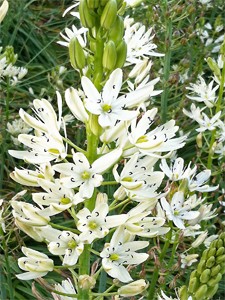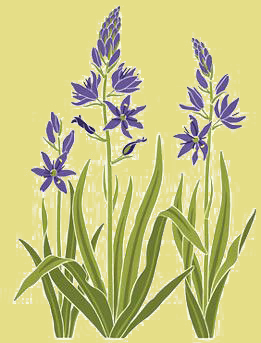Camas



Images by Lindsey Vallance
In the wild, Camassia leichtlinii, commonly known as great camas, is found in damp mountain meadows and grasslands. When Meriwether Lewis first sighted camas in bloom in 1806, he described the meadows as resembling "lakes of fine clear water."
In the Buck Lake Native Plant Garden, the camas meadow was located near the garden's south entrance, and featured two different varieties and one cultivar of Camassia leichtlinii. Camassia leichtlinii caerulea, is 24"-30" tall with deep lavender-blue flowers, C. leichtlinii alba, is of similar stature, with creamy white flowers and the smaller C. leichtlinii 'Blue Heaven,' sports pale sky-blue flowers. The other familiar Northwest camas species, Camassia quamash, known as common camas, is almost indistinguishable from great camas in appearance and grows in the same habitat.
Currently, camas in not to be found in the BLNPG; it had become very difficult to maintain. In fall 2021, volunteers cleared out the camas field and gave away the many hundreds of bulbs. However--and this is how tenacious the plant is once established--the camas field came back stronger than ever in 2022! This time, after they bloomed, machinery was brought in to dig it all out. A cover crop was planted in the meadow, and in spring 2024 there will be new plantings, yet to be decided.
Camas prefers a sunny location, plenty of winter moisture and little to no moisture in the summer, when it goes dormant. It is tolerant of a variety of soil conditions, even thriving in heavy clay. In the BLNPG, it put on its beautiful bloom display in April and May. Camassia leichtlinii caerulea and C. leichtlinii 'Blue Heaven' began the show in April, followed by C. leichtlinii alba in May. Planted initially as bulbs, when the flowers are allowed to die back naturally and set seeds, they naturalize freely. Camas flowers provide nectar for butterflies, bees and hummingbirds. Deer and Elk browse the leaves.
Camas bulbs were an important staple food for the native population in the Western U.S. and Canada. Bulbs were harvested in the autumn, after the plants died back, and were baked or pounded into flour. They were such an important food source that fields of camas were cultivated and, in some tribes, were owned and inherited.
See the links below for more information on camas.

